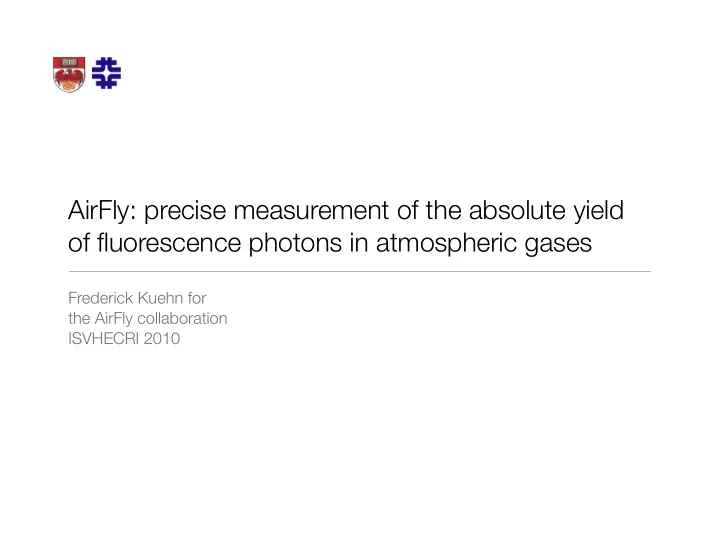

AirFly: precise measurement of the absolute yield of fluorescence photons in atmospheric gases Frederick Kuehn for the AirFly collaboration ISVHECRI 2010
Purpose: Fluorescence energy determination • Energy deposited in the atmosphere by the induced cosmic ray shower is related to the fluorescence light emitted by excited Nitrogen molecules • Need an absolute calibration to determine the Pierre Auger Observatory energy scale • Goal is to measure the fluorescence yield per MeV deposited to a few percent N λ T( λ ) A R i ε ( λ ) 2
Astropart. Phys. 28 (2007) 41 AIRFLY Bunner (1964) FILTER 34 band intensities measured (relative to the 337 nm line) 3
AIRFLY measurements 353.7 nm 313.6 nm 337.1 nm 4
N 337 (fluo) = Y fl × Geom fluo � × T filter × QE 337 � × N p Method & � �� � � �� � �� ���� measured known MC ∼ cancel relative setup � �� � � �� � � �� � � �� � ���� N 337 (cere) = Y cere Geom cere × T filter × QE 337 × N p × Beam Beam defining counter • Compare fluorescence yield to a well known Veto counter process to eliminate Integrating sphere photo-detector Shutter systematics Photon • The ratio of Fluorescence/ Detector Cherenkov make many systematics cancel Diffuser for Cherenkov run • Also used a laser for Cherenkov absolute calibration cross dump Gas/Vacuum check container Veto counter ~ 3 fluorescence Acceptance counter photoelectrons per 10 4 Cherenkov trigger rod protons in air 5
Experimental setup Cherenkov White Gore highly UV reflective rod hidden material inside sphere by dump dummy Cherenkov dump signal PMT To preserve the optical geometry a second diffuser opens and closes a dummy vetos Cherenkov dump perpendicular to the beam Diffuser Beam defining actuator counter
Beam structure @ M-Test (120 GeV protons) UV transparent acrylic rod 1 spill / min Several 10 5 particles/spill PMT 4 s Spill Summed traces 10 µs train over a spill using a 500 MHz FADC 19 ns bunch Up to 70 bunches 7
Cherenkov rod spectrum Single particle triggering PMT glass ped 1p Veto • Require limit on max veto signal PMT • Beam defining counter (“finger”) signal in peak region • Cherenkov rod signal in peak • Impose a time based isolation window of ±80 ns • Defines a “single particle” • 25% of trains pass the requirements • ~1.1 single particles per train
Photon counting • Select single charged particles passing through the chamber • Search in (±80 ns) time window defined by single particle trigger for a single photoelectron • Require that single photoelectron trigger occurs after single charged particle trigger •Time distribution of single Photon arrival photoelectrons used to determine yield time distribution Time constant • Data taking conditions: Exponential plus determined by constant fit function • Cherenkov/Fluorescence modes, sphere geometry gas type (N, Ar, Air, He), primary Cherenkov & particle (p,e - , π ), pressure fluorescence photon are (vacuum → atm), photon detector prompt shutter position (closed/open) 9
Backgrounds • Measure fluorescence & Cherenkov signal in vacuum, helium (should have ‘zero’ signal), air, and argon (no 337nm excitation line), with the shutter open and closed • Checked background from exit port and delta rays • Background is about 3% of Nitrogen signal fluorescence signal PMT photon shutter (open/closed) charged particles (e.g., 120 GeV protons) delta rays Cherenkov port (open) integrating Cherenkov 10 sphere photon
Backgrounds • Measure fluorescence & Cherenkov signal in vacuum, helium (should have ‘zero’ signal), air, and argon (no 337nm excitation line), with the shutter open and closed • Checked background from exit port and delta rays • Background is about 3% of Nitrogen signal fluorescence signal PMT photon shutter (open/closed) charged particles (e.g., 120 GeV protons) delta rays Cherenkov port (closed) integrating Cherenkov 11 sphere photon
337 nm In situ laser laser calibration Integrating sphere Second Photon integrating Detector sphere collimator Cherenko During the setup at M-Test dump NIST Calibrated Photodetector (5% absolute scale) Second integrating sphere plus 337 nm Nitrogen laser collimator Independent calibration method Efficiency of the second sphere measured to be ε sph = 2.49 · 10 -6 12
Analysis & preliminary results • Current measurements of Fluorescence in Nitrogen give ( preliminary numbers! ) } • 19.48 ± 0.15 (stat) x 10 -4 photons/proton • 18.6 ± 0.51 (stat) x 10 -4 photons/pion Systematic uncertainty at the level of 4% • 18.95 ± 1.12 (stat) x 10 -4 photons/electron • Current measurements of Cherenkov yield in Nitrogen give ( preliminary numbers! ) • 10.17 ± 0.22 (stat) x 10 -4 photons/proton • Laser calibration gives consistent results within 5% • GEANT simulation needed to convert Cherenkov/fluorescence ratio to the yield ongoing • ~5 photons/MeV consistent with other experiments N 337 (fluo) = Y fl × Geom fluo � × T filter × QE 337 � × N p � �� � � �� � �� ���� measured known MC ∼ cancel relative � �� � � �� � � �� � � �� � ���� N 337 (cere) = Y cere Geom cere × T filter × QE 337 × N p × 13
Summary • Absolute yield measured to ~10% in early data runs (June 2009) • Two independent calibrations give consistent results within 5% • Currently analyzing data taken in December 2009 and January 2010 • Confirms earlier results with improved statistical and systematic uncertainties • Measurements with different particles confirms that fluorescence is proportional to energy deposited • Final uncertainty of a few percent is within reach • Expect final results by the end of the year 14
Recommend
More recommend